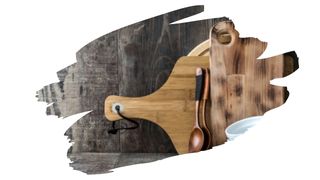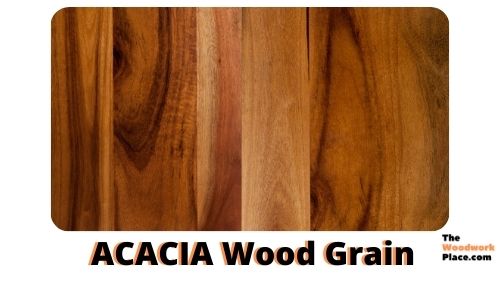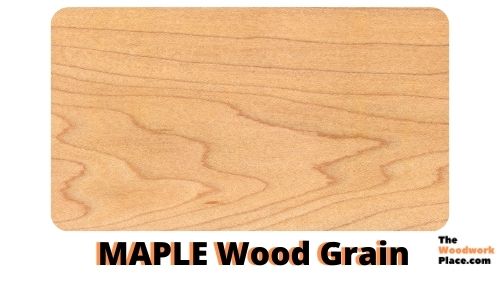You probably already know that Maple cutting boards are a cut above the rest. Popularly used as a go-to lumber for chopping blocks, Maple wood is easy to work, easy to attain, and easily affordable.
And then there’s Acacia wood. A fast-rising star in the world of cutting boards, this hardwood is more expensive than Maple… and for good reason.
It is durable, naturally moisture-resistant, and tough as nails. All things you’re looking for in any cutting board. So, why wouldn’t you choose an Acacia cutting board over Maple wood?
Well, in this post, we’re going to cover the four key criteria that every quality cutting board needs to meet.
And we’re also going to compare Acacia to Maple, to see how these two hardwoods hold up when pitted against one another. So, let’s get straight into it…

This post may contain affiliate links to products that we receive a commission for (at no additional cost to you). Learn more here.
What’s The Best Wood To Use For A Cutting Board?
The best types of cutting boards are made from wood that is hard enough to handle the bite of sharp kitchen utensils.
But, there’s more to it than that. Optimal cutting board lumber needs to meet four key criteria:
1) It Needs To Be Tough…
A cutting board obviously needs to be made from tough wood that can handle the daily chop… without splintering into bits. And, one of the ways we measure woods toughness is by using the Janka Hardness Scale.
All lumber is given a Janka rating (based upon this scale). And that rating simply measures how many pounds of force it takes to make a single dent in a piece of wood.
The higher the Janka rating, the tougher the wood.
For example, Maple wood has a Janka rating of 1450. So it takes 1450 lbs of force (lbf) to make a dent in this hardwood.
Australian Blackwood, (also referred to as Acacia blackwood), has a Janka rating of 1160. So, it will take 1160 lbf to splinter this lumber.
And Raspberry Jam Acacia wood, (also known under its scientific name ‘Acacia acuminata’), has a Janka rating of 3,100. Which means it takes an astonishing 3100 pounds of force to make a real impact in this incredibly dense lumber.
However, when it comes to cutting boards, the minimum optimal Janka rating requirement isn’t quite so high.
Ideally, cutting board wood should have a Janka rating of at least 900 at a bare minimum. Anything less than that, and it won’t last very long in the kitchen.
2) …But It Can’t Be Too Tough
When it comes to cutting boards, there really is a thing as wood being ‘too tough’.
Don’t get us wrong, all cutting board wood needs to be hard and dense. But, you can take it too far.
You see, if wood is too dense, it’s going to damage your kitchen tools. This is why optimal cutting board wood should not have a Janka rating higher than 1500.
3) It Needs To Be Food Safe
Wood is a naturally antibacterial material. And this is all thanks to its superb ability to soak up water efficiently (something that is referred to as ‘hygroscopy’).
Woods hygroscopicity means that it will draw meat juices and liquids down and away from the surface. And this in turn limits the opportunity for bacteria to thrive inside that liquid.
However, while most types of wood are hygroscopic, not all types of wood grain are best suited for cutting board surfaces.
Open-grained wood, (such as Red Oak), make it far too easy for bits of food to get caught up in their grain. Which can risk cross-contamination between raw meat and cooked food.
So, cutting board lumber should ideally have tight—or otherwise very close—grain.
4) And, Lastly, It Needs To Look Good!
While appearances aren’t everything, they still matter all the same. Especially when cutting boards work double duty as both a kitchen utensil and as a decorative piece.
OK then! Now that you’re all caught up on the key cutting board criteria, let’s begin comparing Acacia to Maple…
Acacia Cutting Board Pros And Cons

Acacia Pros (What’s So Special About Acacia Wood Anyway?)
Durability
Is Acacia Harder Than Maple?
There are many different subspecies of Acacia wood. And unfortunately, each species isn’t always clearly labelled on Acacia wood crafts.
You’ll be lucky to find a listing that states little more than it being ‘Acacia’ wood, (giving no further info as to the exact subspecies).
Which is a shame, because Acacia wood density ranges widely.
There are Acacia wood subspecies that are incredibly soft (with Janka ratings of less than 50 lbf). And one’s that are fantastically dense (with Janka ratings over 4,000 lbf!).
And, without knowing which subspecies of Acacia that cutting board is made from, you can’t be sure of which rating it falls under. But, if you know the subspecies, there are a few Acacia subspecies that are just the right density for a cutting board.
You should try and get Acacia more in the range of the Acacia blackwood (also known as the Australian Blackwood). This particular Acacia wood subspecies, (with its 1160 lbf Janka rating), is well within the optimal Janka range for a cutting board.
And Does Acacia Wood Rot?
Lack of clear subspecies labelling aside, the reason why durability is classed as an Acacia pro is because of it’s natural rot resistance.
Acacia is an oily wood. Which means that this timber is saturated with its own natural wood preservative. This natural oil acts like mineral oil, making Acacia wood moisture-resistant.
Acacia wood is far from the only wood that is naturally rot-resistant. Teak wood is another naturally oily wood, so much so, that it can be left untreated without needing any penetrating oil treatments.
Related Post: Can You Apply Lemon Oil On A Teak Wood Surface?
Still, Acacia wood isn’t as oily as Teak wood, and it will still need a regular application of mineral oil to keep that cutting board in tip top condition. However, those moisture-resisting natural oils will help Acacia wood stay in peak condition a lot longer than Maple wood.
Food Safety
Is Acacia Wood Safe For Food?
Yes it is. This lumber has uniquely wavy, (yet close), grain. This pairs perfectly with it’s ability to naturally act like an antibacterial surface (just like most hardwoods).
Especially as it’s close grain leaves no hidden spots for bacteria to grow on little bits of trapped food.
Acacia Cons
Suitability
Is Acacia Wood Good For Cutting Boards?
If you can get an Acacia chopping block that falls into that optimal Janka hardness density range, then it will be perfect as a cutting board.
But, all too often, the specific subspecies of Acacia gets (inexplicably) left off the labelling. This makes buying an Acacia cutting board an iffy proposition, because you can’t be too sure as to what you’re getting (in terms of density).
Is Acacia Wood Harder Than Maple? It depends on the Acacia subspecies. Gidgee (Acacia cambagei) is nearly 3 times harder than Hard Maple, and it clocks in at a Janka rating of 4270! While Hard Maple is around 30 times harder than Silver Wattle (Acacia dealbata). And Silver Wattle will snap like a twig with its mere 40.9 Janka rating.
Appearance
Does Acacia Wood Turn Gray?
Acacia wood has a rich deep brown color to it. Although, depending on the subspecies, it can range from a honey amber hue, all the way to a deep Mahogany tone.
However, all Acacia wood will naturally darken… even more so if exposed to enough sunlight. With time, those UV rays will keep on changing the color of this lumber.
So, don’t be surprised if Acacia wood (that’s regularly left in a brightly sunlit kitchen) begins to turn gray.
Related Post: Is Acacia Wood A Good Choice For Firewood?
Maple Cutting Board Pros And Cons

Maple Pros (Why Are Maple Cutting Boards So Popular)?
Suitability
Is Maple Wood Good For Cutting Boards?
By far, one of the most reliable cutting board wood types is Maple wood.
Whether it be Hard Maple (1450 lbf Janka), or Soft Maple (950 lbf Janka), this tight-grained hardwood has everything you need in cutting board lumber.
Its affordable, easily accessible, and is clearly labeled too!
Related Post: Cherry Vs Maple Cutting Boards (3 Essential Comparisons)
Food Safety
Are Maple Cutting Boards Sanitary?
Maple cutting boards are sanitary and antibacterial. Plus, their grain is even more tightly packed than Acacia’s.
And Maple will actively work just as efficiently, (as any other hardwood lumber), at keeping harmful bacteria away from its food-prepping surface.
Maple Cons
Durability
Is Maple Wood As Rot Resistant As Acacia?
Maple is not a rot-resistant wood at all—and cannot even be compared to Acacia on this point. In fact, Maple hardwood will easily succumb to rot and decay without the help of a quality sealing finish.
Now, generally, cutting boards aren’t 100% waterproofed. We seal them with mineral oil as a wood finish to protect them. However, these items aren’t wrapped in a waterproofed sealant (for food safety reasons).
Basically, that Maple cutting board will last much longer with mineral oil saturating it. However, it won’t last as long as a moisture-resistant Acacia wood cutting board.
Appearance
What Color Does Maple Wood Turn To?
One of the other cons to Maple wood is it’s rather plain appearance. It’s grain has some interesting patterning to it, but not enough contrast to make it stand out.
This cream-toned hardwood has barely a hint of a red tint to it. And while given time, it’s color will turn more golden, it won’t be strong enough to enhance the look of its wood grain.
So, Which One’s Better For Cutting Boards? Acacia Or Maple?
For cutting board wood, both of these wood types are food safe surfaces that won’t bring a cross-contamination hazard into your kitchen.
And, provided you can find the right type of Acacia chopping block, both timber types are great for cutting boards. However, if you had to choose based on:
…Durability As A Cutting Board – Acacia wood wins out. It’s inherent moisture resistance means it can handle regular washing better than Maple can.
Especially if the only wood finish being used to seal that cutting board is a non-durable mineral oil finish.
…Suitability As A Cutting Board – Maple wood wins out. Both Acacia wood and Maple wood are equally suitable in theory.
But, in practice, it’s fairly difficult to find out which type of Acacia subspecies cutting board you’re getting.



